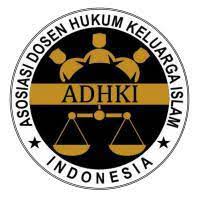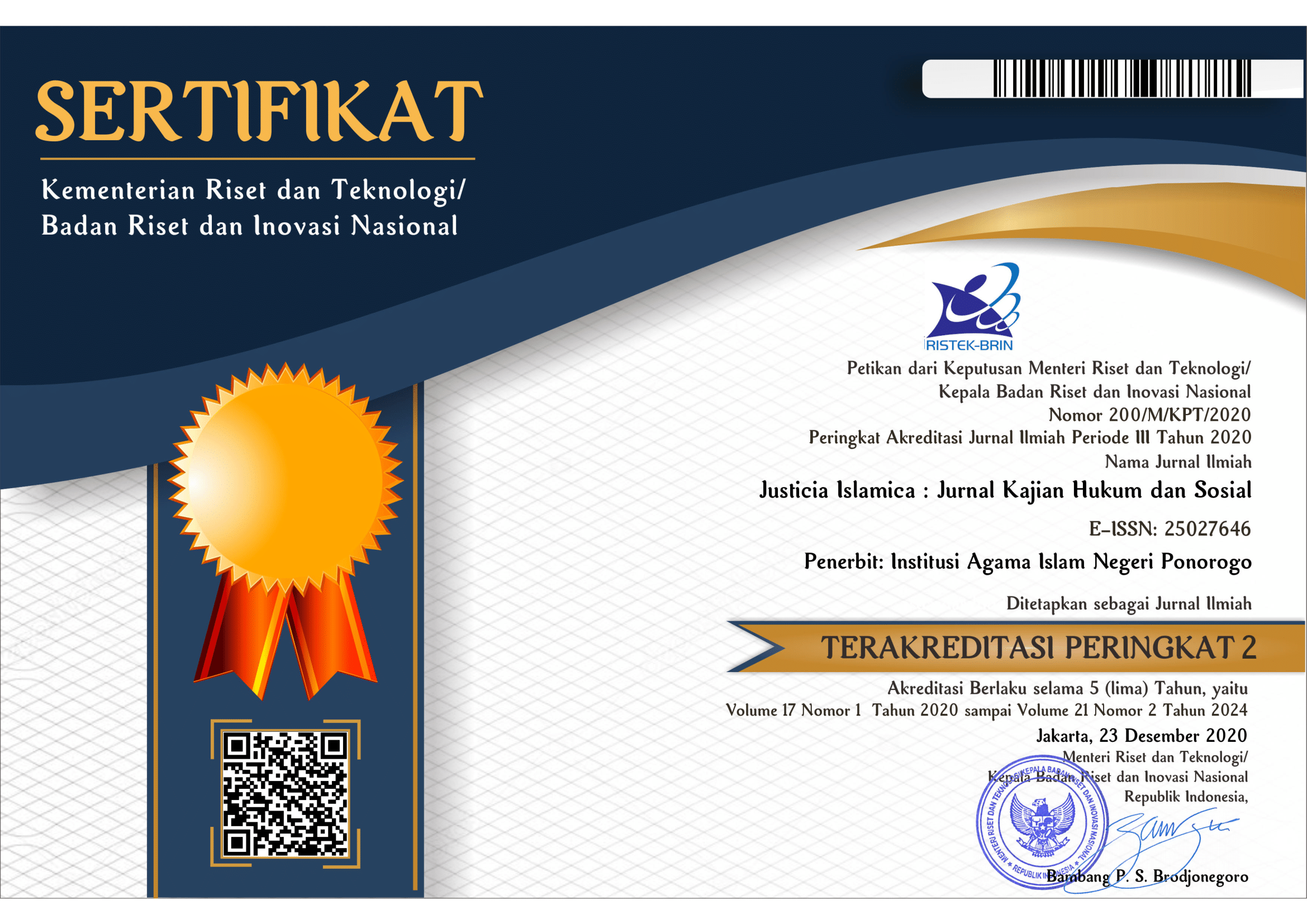The Role of North Aceh Government for Building Women's Capacity Based on Islamic Values in Vocational Village
DOI:
https://doi.org/10.21154/justicia.v18i1.2308Keywords:
role of the government, empowerment, women, vocational villageAbstract
Women have potential contributions to engage in productive activities and can help the family economy. A vocational village is a village setting a model for developing its local resources to improve inhabitants' quality of life, especially women in the village in North Aceh District, without leaving their Islamic values. This article described the role of government in enhancing women's capacity and local potential in the vocational village with Islamic values using the empirical methodology. Data is obtained based on field research through purposive sampling collected by interviews with informants using qualitative analysis data. This study found that several training initiatives had been carried out to increase women's capacity, such as training in embroidery, handicrafts, etc. However, these initiatives were not based on the potential components that live in the village. Furthermore, Islamic values in the community in encouraging women in North Aceh have experienced a shift in Pande Village. This study recommends more efforts to increase women's potential by promoting and exhibiting local products for empowering women in villages based on existing prospects without leaving Islamic values.
References
Adib Afdholi, Aufarul Marom, Fathurrohman. “Implementasi Program Desa Vokasi Di Kota Semarang.” Journal of Public Policy and Management Review 4, no. 3 (2015): 1”“8.
Aida Vitayala S. Hubeis. Pemberdayaan Perempuan Dari Masa Ke Masa. IPB Press, 2011.
Andrea Cornwall. “Women’S Empowerment: What Works.” Journal of International Development 28 (2016): 341”“59. https://doi.org/10.1002/jid.
Astuti, Rizky Viandari, and Tri Suminar. “Model Kemitraan Desa Vokasi Dalam Pemasaran Produk Wirausaha Gemawang Kecamatan Jambu Kabupaten Semarang.” Jurnal Pendidikan Nonformal 13, no. 2 (2018): 54”“62.
Ayuningrum, D & Dewi S, Paulla. “Pengaruh Program Desa Vokasi Terhadap Perkembangan Perekonomian Masyarakat Desa Kopeng Kecamatan Getasan Kabupaten Semarang.” Jurnal Teknik PWK 2, no. 1 (2013): 76”“84.
Azizah, Siti Nur. “Pengembangan Ekonomi Kreatif Berbasis Kearifan Lokal Pandanus Handicraft Dalam Menghadapi Pasar Modern Perspektif Ekonomi Syariah ( Study Case Di Pandanus Nusa Sambisari Yogyakarta ).” Aplikasia 17, no. 2 (2017): 63”“78.
Busch, Noël Bridget, and Deborah Valentine. “Empowerment Practice: A Focus on Battered Women.” Affilia - Journal of Women and Social Work 15, no. 1 (2000): 82”“95. https://doi.org/10.1177/08861090022093840.
Castillejo, Clare. “Building a State That Works for Women: Integrating Gender into Post-Conflict State Building,” 2011.
Cdefor Panorama series; 103. “Towards a History of Vocational Education and Training (VET) in Europe in a Comparative Perspective.” In Towards a History of Vocational Education and Training (VET) in Europe in a Comparative Perspective, I:1”“169, 2002.
Cornwall, Andrea, and Nana Akua Anyidoho. “Introduction: Women’s Empowerment: Contentions and Contestations.” Development 53, no. 2 (2010): 144”“49. https://doi.org/10.1057/dev.2010.34.
Dewi Nurul Qamariyah. “Pemberdayaan Perempuan , Kemandirian Finansial , Kemandirian Ekonomi , Home Industry.” An-Nisa 11, no. 2 (2018): 145”“58.
Duflo, Esther. “Women Empowerment and Economic Development.” Journal of Economic Literature 50, no. 4 (2012): 1051”“79. https://doi.org/10.1257/jel.50.4.1051.
Ferezagia, Debrina Vita. “Analisis Tingkat Kemiskinan Di Indonesia Jurnal Sosial Humaniora Terapan.” Jurnal Sosial Humaniora Terapan 1, no. 1 (2018): 1”“6.
Hafni Zahara. “Kapasitas Perempuan Dalam Pengembangan Usaha Ekonomi Kreatif Kerajinan Bordir Aceh Di Kabupaten Aceh Utara.” AGRIFO 3, no. 1 (2018): 30”“38.
Harlik, Amir Amir, and Hardiani. “Faktor-Faktor Yang Mempengaruhi Kemiskinan Dan Pengangguran Di Kota Jambi.” Persepektif Pembiayaan Dan Pembangunan Daerah 1, no. 2 (2013): 109”“20. https://online-journal.unja.ac.id/JES/article/view/1500.
Lutfiyah, Lutfiyah. “Pemberdayaan Wanita Berbasis Potensi Unggulan Lokal.” Sawwa: Jurnal Studi Gender 8, no. 2 (2013): 213. https://doi.org/10.21580/sa.v8i2.653.
M Shabri Abd Majid. “Analisis Tingkat Pendidikan Dan Kemiskinan Di Aceh.” Jurnal Pencerahan 8, no. 1 (2014): 15”“37. https://doi.org/10.13170/jp.8.1.2040.
Malik, Abdul, and Irene Astuti Dwiningrum. “Keberhasilan Program Desa Vokasi Terhadap Pemberdayaan Masyarakat Di Desa Gemawang Kabupaten Semarang the Success of the Vocational Program for Community Empowerment in Gemawang Village, Semarang Regency.” Jurnal Pendidikan Dan Pemberdayaan Masyarakat 1, no. 2 (2014): 124”“35.
Maseray Ngadie Rogers. “Capacity Building For Women in African Countries, A Case Study of Sierra Leone.” Ghana Journal Of Development Studies 7, no. 1 (2010).
Matthoriq, Suryadi, Mochamad Rozikin. “Aktualisasi Nilai Islam Dalam Pemberdayaan Masyarakat Pesisir (Studi Pada Masyarakat Bajulmati, Gajahrejo, Kecamatan Gedangan, Kabupaten Malang).” Jurnal Administrasi Publik 2, no. 3 (2014): 426”“32. http://administrasipublik.studentjournal.ub.ac.id/index.php/jap/article/view/405.
Mubarak, Zaki. “Evaluasi Pemberdayaan Masyarakat Diitnjau Dari Proses Pengembangan Kpasitas Pada Kegiatan PNPM Mandiri Perkotaan Di Desa Sastrodirjan Kabupaten Pekalongan.” Universitas Diponegoro, 2010.
Muhammad Asri, Oong Komar. “Pemanfaatan Hasil Pelatihan Keterampilan Dan Peran Pendamping Dalam Meningkatkan Kemandirian Usaha (Studi Pada Program Desa Vokasi Di Desa Cisaat Kecamatan Ciater Kabupaten Subang Provinsi Jawa Barat),” n.d.
Nugrahani, Tri Siwi, Sri Rejeki, and Rosalia Indriyati Saptatiningsih. “Pemberdayaan Perempuan Desa Untuk Mengurangi Kemiskinan.” Seminar Nasional Universitas PGRI Yogyakarta, 2015, 512”“24.
Ogbonna, K I, and E Okoroafor. “Enhancing The Capacity Of Women For Increased Participation In Nigeria Main -Streaming Agriculture : A Re-Designing Of Strategies.” In Farm Management Association of Nigeria Conference, 33”“48, 2004.
Pakarti, Piji. “Potensi Pengembangan Industri Kecil Desa Vokasi ( Studi Pada Desa Vokasi Sojokerto Kecamatan Leksono Kabupaten Wonosobo ).” Infokam, no. 1 (2016): 35”“43.
Pratama, Yoghi Citra. “Analisis Faktor-Faktor Yang Mempengaruhi Kemiskinan Di Indonesia.” Esensi 4, no. 2 (2015): 210”“23. https://doi.org/10.15408/ess.v4i2.1966.
Rohmiati Amini. “Pemberdayaan Masyarakat Melalui Program Desa Vokasi Babussalam Untuk Menciptakan Desa Wirausaha.” Media Bina Ilmiah 1, no. 2 (2018): 103”“8.
Siska Saktyawati, Joko Sutarto, Sungkowo Edy Mulyono. “Kewirausahaan Masyarakat Melalui Desa Vokasi Di Desa Gemawang Kecamatan Jambu Kanupaten Semarang.” Journal of Non Formal Education and Community Empowerment 1, no. 2 (2012): 33”“39.
Sugiharto, Dwi Yuwono Puji, and Rafika Bayu Kusumandari. “Model Development in the Context of Vocational Village Community Empowerment in Central Java.” International Journal of Information and Education Technology 6, no. 7 (2016): 564”“69. https://doi.org/10.7763/ijiet.2016.v6.752.
Sukmaniar. “Efektivitas Pemberdayaan Masyarakat Dalam Pengelolaan Program Pengembangan Kecamatan (PPK) Pasca Tsunami Di Kecamatan Lhoknga Kabupaten Aceh.” Universitas Diponegoro, 2007.
Sururi, Ahmad, and Rahmi Mulyasih. “Pemberdayaan Masyarakat Melalui Inovasi Perencanaan Pembangunan Berbasis 4R ( Rembug , Rencana , Realisasi Dan Rawat ) Di Desa Cilangkap Kecamatan Wanasalam Sebagai Pilar Utama Kebijakan Partisipatif Dan Gotong Royong.” Engagament Jurnal Pengabdian Masyarakat 1, no. 2 (2017).
Tohani, Entoh, Iis Prasetyo, and RB. Suharta. “Women Empowerment in Disaster Vulnerable Village Through Vocational Life Skill Education Based on Utilization of Local Potential.” Journal of Nonformal Education 5, no. 1 (2019): 35”“46. https://doi.org/10.15294/jne.v5i1.18341.
Zakiyah. “Pemberdayaan Perempuan Oleh Lajnah Wanita Dan Putri Al-Irsyad Surabaya.” Analisa XVII, no. 01 (2010): 37”“56.
Zuhdiyati, Noor, and David. “Analisis Faktor-Faktor Yang Mempengaruhi Kemiskinan Di Indonesia Selama Lima Tahun Terakhir (Studi Kasus Pada 33 Provinsi).” Jibeka 11, no. 2 (2017): 27”“31.
Downloads
Published
Issue
Section
License
Requirements to be met by the author as follows:
- Author storing copyright and grant the journal right of first publication manuscripts simultaneously with licensed under the CC BY-SA allows others to share the work with a statement of the work's authorship and initial publication in this journal.
Authors can enter into the preparation of additional contractual separately for the non-exclusive distribution of a decadent version of the journal issue (e.g., post it to an institutional repository or publish it in a book), with the recognition of initial publication in this journal.
Authors are allowed and encouraged to post their work online (e.g., in institutional repositories or on their website) before and during the submission process because it can lead to productive exchanges and citations earlier and more severe than published works. (see The Effect of Open Access).
This work is licensed under CC BY-SA.


















